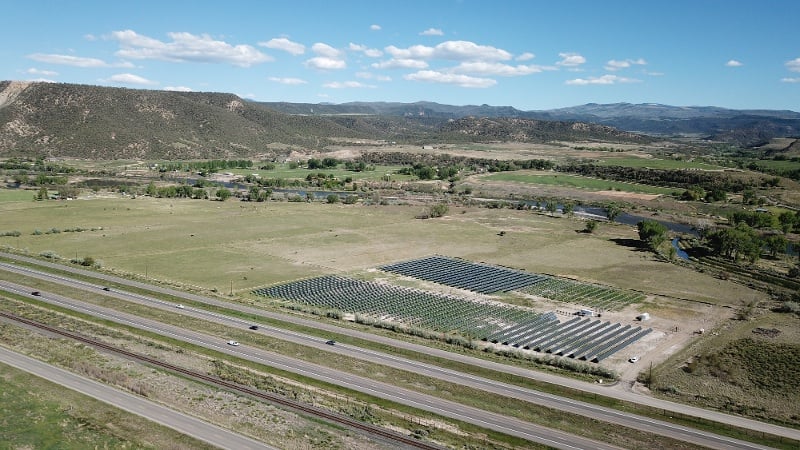Where To Build Solar: Working With Locals and Landowners
December 22, 2022

Solar energy requires a lot of land, and not just any land will do. Ideally, solar arrays are located on flat, dry, sunny areas near existing power lines. In 2021, a report from the National Renewable Energy Laboratory found that roughly 22,000 square miles of solar panel-filled land (about the size of Lake Michigan) would be required to power the entire country. Again, that’s a LOT of land. (Note: the actual amount of land needed for solar farms will inevitably be considerably less thanks to other forms of renewable energy generation – wind, geothermal, nuclear, etc.)
When determining where to position a solar project, developers must consider a number of variables: location, proximity (to power lines as well as to residential or commercial development), traditional use of the land in question, and more. At Pivot, we are committed to positively contributing to the communities we serve, which is why we prioritize striking a perfect balance between all of these important factors. Here we dive into exactly how we do that.
What Is The Ideal Land For Solar Development?
The ideal landowner for Pivot and other solar developers is someone who views solar as the best option for their land, maximizing its economic and environmental potential. You see, there is a lot of farming land across the nation that for one reason or another is no longer suitable for producing crops. Climate change is altering weather patterns and ruining countless family businesses by making more and more plots of land “unproductive”. For such farmers and landowners, solar is an incredibly attractive option that: diversifies their portfolio, generates a reliable stream of revenue, allows former farmland to rejuvenate, and keeps the land in their family.
You might be wondering why land would not be farmable. Well, sometimes the owner’s soil is too rocky or dry for any roots to take hold. These landowners might try four or five different crops with the hope of breaking up the soil but are unrewarded for their efforts. Some plots of land have run out of topsoil and thus are no longer farmable. (Note: Every year a farmer tills their land, they shave away a layer of topsoil, which will eventually run out!) Additionally, droughts across the nation – particularly in the midwest – have led to water shortages that have made it difficult for many farmers to obtain enough water to keep crops alive throughout the seasons. For all of these landowners, solar becomes the best use of their land.
At the end of the lease, the solar developer will return your property to “ready-to-plant” or “ready-to-develop” condition. This ensures that the landowner isn't left with a useless plot after the lease expires. The land will be ready for whatever they decide to do with it next!
Solar Farm Land Lease Benefits
A solar lease provides landowners with a steady source of income for decades while protecting them from the variability and unpredictability that often comes with agricultural and other applications. When leasing property to a solar developer, you enter into a contract that guarantees regular payments for the duration of the lease period, regardless of soil quality, access to water, and seasonal weather patterns. This is a great way to earn income while ensuring that you can pass down your land to the next generation – a process known as “land banking.”
Land banking is a great way to boost passive income while simultaneously reducing your labor expenditure. Throughout the duration of your lease, your solar developer assumes all responsibilities associated with financing and maintaining the site. You don’t need to worry about anything; your developer will handle all of the construction of the system and any ongoing site maintenance. As the landowner, you can simply sit back and watch the rent roll in.
It’s worth noting that despite common misconceptions about solar systems, the reality is that solar makes a great neighbor. It takes as little as two months for a system to be constructed, all while creating minimal disruptions to you or your community. Once operational, the system produces no emissions, no noise, and doesn't bring additional traffic or light pollution to your neighborhood. What’s more, your neat rows of solar panels will be low profile, so your neighbors can continue to enjoy the beautiful view outside their windows.
Is Solar Right For Your Land?
Pivot Energy considers many factors when deciding what land to pursue for solar development. As a company, Pivot prides itself on its capacity to work with individual landowners and local communities to ensure that everyone realizes and experiences the true value that renewable energy can bring to their community – such as cleaner air and energy resiliency.
As an owner-operator, Pivot continues to push itself and the industry by setting the bar higher and higher for project management. For the projects that Pivot owns, when possible, we plant pollinator-friendly flowers and use sheep-grazing grass, striving to have the project mesh seamlessly with the environment. Contact Pivot today if you think installing solar might be the best option for you!

.jpg?width=123&name=Angie%20Agrivoltaics%20Award%20(HQ).jpg)


.jpg?width=400&name=Angie%20Agrivoltaics%20Award%20(HQ).jpg)
